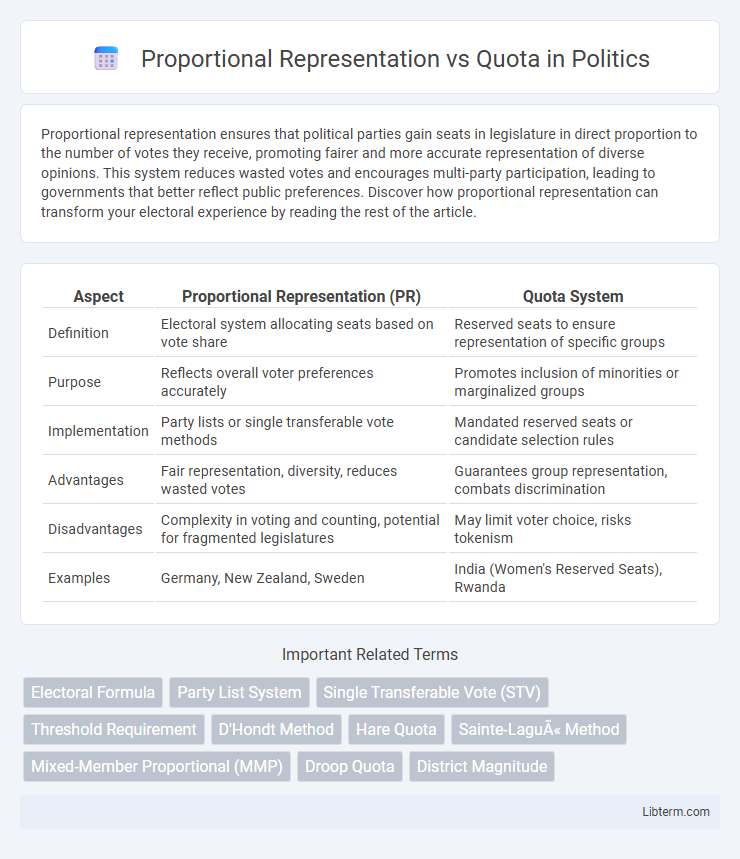Proportional representation ensures that political parties gain seats in legislature in direct proportion to the number of votes they receive, promoting fairer and more accurate representation of diverse opinions. This system reduces wasted votes and encourages multi-party participation, leading to governments that better reflect public preferences. Discover how proportional representation can transform your electoral experience by reading the rest of the article.
Table of Comparison
| Aspect | Proportional Representation (PR) | Quota System |
|---|---|---|
| Definition | Electoral system allocating seats based on vote share | Reserved seats to ensure representation of specific groups |
| Purpose | Reflects overall voter preferences accurately | Promotes inclusion of minorities or marginalized groups |
| Implementation | Party lists or single transferable vote methods | Mandated reserved seats or candidate selection rules |
| Advantages | Fair representation, diversity, reduces wasted votes | Guarantees group representation, combats discrimination |
| Disadvantages | Complexity in voting and counting, potential for fragmented legislatures | May limit voter choice, risks tokenism |
| Examples | Germany, New Zealand, Sweden | India (Women's Reserved Seats), Rwanda |
Introduction to Proportional Representation and Quota
Proportional Representation (PR) is an electoral system designed to allocate seats based on the percentage of votes each party receives, ensuring a broad reflection of voter preferences in legislative bodies. The Quota system, commonly used within PR methods like Single Transferable Vote (STV) or Party-list PR, establishes a minimum number of votes required for a candidate or party to gain a seat, such as the Droop or Hare quota. PR systems enhance fairness and diversity in representation by matching the composition of elected officials closely with the electorate's voting patterns, while quotas ensure efficient seat distribution and prevent vote wastage.
Defining Proportional Representation
Proportional representation is an electoral system designed to allocate seats in a legislature in direct proportion to the percentage of votes each party receives, ensuring fair and accurate reflection of voter preferences. Unlike quota systems that set fixed seat thresholds for candidates or parties, proportional representation promotes inclusivity by enabling smaller parties to gain representation based on overall support. This method enhances political diversity and strengthens democratic legitimacy by aligning legislative outcomes with the electorate's varied interests.
Understanding Electoral Quotas
Electoral quotas are critical in proportional representation systems, defining the minimum number of votes a candidate or party needs to secure a seat. The Droop quota and Hare quota are the most commonly used formulas, designed to ensure fair and proportional allocations that reflect voter preferences. Understanding these quotas helps clarify how votes are translated into legislative representation, minimizing wasted votes and promoting inclusivity in multi-member districts.
Key Differences Between Proportional Representation and Quota
Proportional representation allocates seats in a legislative body based on the percentage of votes each party receives, ensuring that political diversity reflects voter preferences accurately. In contrast, quota systems set a fixed number or percentage of seats reserved for specific groups, such as women or minorities, to guarantee their representation regardless of electoral outcomes. The key difference lies in proportional representation emphasizing overall vote share while quota prioritizes targeted inclusion to address representational imbalances.
Advantages of Proportional Representation
Proportional Representation (PR) ensures fairer political diversity by allocating seats in legislative bodies based on the percentage of votes each party receives, enhancing inclusivity and minority representation. It reduces wasted votes, increasing voter turnout and engagement by making every vote contribute to election outcomes. PR systems tend to produce coalition governments that better reflect the electorate's preferences, leading to more consensus-driven and stable policymaking.
Benefits of Implementing Quotas
Implementing quotas in electoral systems guarantees increased representation of marginalized groups, promoting diversity and inclusion in governance. Quotas ensure that underrepresented populations, such as women and minorities, gain fair access to political power, enhancing democratic legitimacy. This targeted approach addresses systemic inequalities more effectively than proportional representation alone by mandating minimum participation levels.
Challenges and Criticisms of Proportional Representation
Proportional Representation often faces challenges such as the complexity of vote counting and the risk of fragmenting legislatures into numerous small parties, which can lead to unstable coalition governments. Critics argue that it may weaken the direct link between representatives and their constituents, reducing accountability and voter engagement. Furthermore, the system can sometimes empower extremist parties disproportionately, complicating consensus-building and policy implementation.
Drawbacks and Controversies of Quota Systems
Quota systems in proportional representation often face criticism for promoting rigid candidate selection, which can limit voter choice and undermine meritocracy. These systems may also trigger disputes over arbitrary threshold levels, potentially excluding smaller parties and skewing political diversity. Controversies arise from perceptions of tokenism, where candidates are selected primarily to meet quotas rather than qualifications, raising concerns about authenticity and effective representation.
Global Examples: PR and Quota in Practice
Proportional Representation (PR) systems like those in Germany and New Zealand allocate seats based on the percentage of votes each party receives, ensuring diverse political representation. Quota systems, such as India's reservation of parliamentary seats for Scheduled Castes and Tribes, guarantee specific group representation to address historical inequalities. Both models demonstrate varied global approaches to enhancing inclusivity and fairness in democratic governance.
Choosing the Optimal Electoral System
Choosing the optimal electoral system requires balancing proportional representation, which ensures parties gain seats closely matching their vote share, against quota systems that secure minimum representation for minorities or specific groups. Proportional representation promotes fairness and inclusivity in multi-party democracies, while quota mechanisms address underrepresentation and enhance diversity within legislative bodies. Evaluating factors such as political diversity, voter equity, and minority rights is essential for selecting a system that fosters both legitimacy and effective governance.
Proportional Representation Infographic

 libterm.com
libterm.com